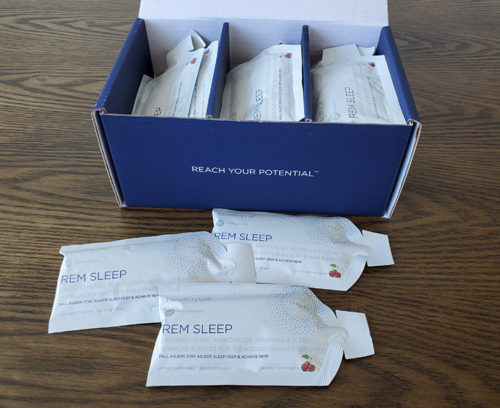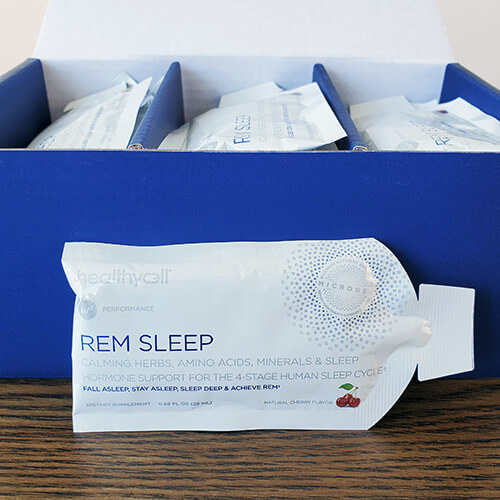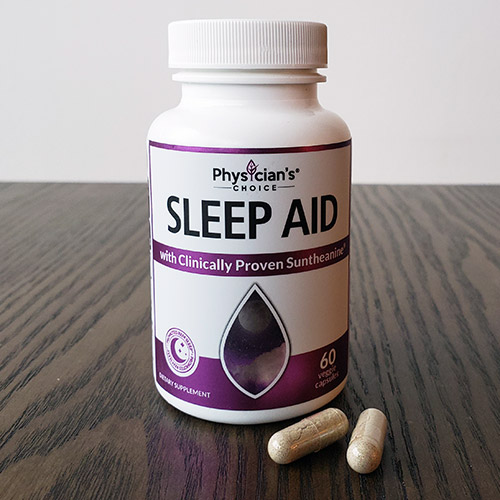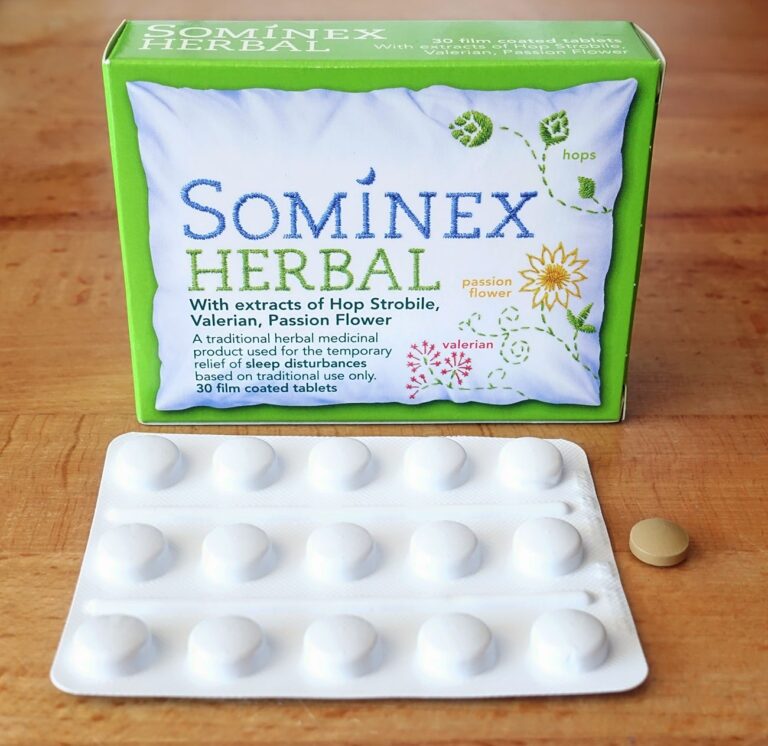
Disclosure: This review is based on my personal experience of taking Healthycell REM Sleep, and you may have a different experience. Please discuss taking any new sleep aid with a healthcare professional rather than only relying on online sources.
Updates: I first wrote this article in 2020 when I tried Healthycell REM Sleep. The most recent update in 2024 was to remove the warnings and side effects listed on the pack I had, and replace them with suggestions of where to find current safety information.
I recently tried Healthycell REM Sleep, a relatively new sleep aid from the company Healthycell. It’s sold online in the United States and doesn’t require a prescription.
I’ve noticed a trend in the last couple of years towards including more and more ingredients in non-prescription sleep aids, and Healthycell’s sleep aid is no exception.
There are 18 active ingredients, ranging from valerian to melatonin and GABA. I can’t help but wonder if the idea is to cover as many bases as possible to potentially satisfy more customers. Or do they know through tests of their own that adding so many ingredients is both effective and necessary?
To find out for myself, I took it every night for a week to see what effect it had. I decided to compare my sleep tracker data that week with three earlier weeks, and also with the week in which I took another multi-ingredient sleep aid – Remrise (which has since been discontinued).
In this review, I’ll first talk about my experience of taking it and how I felt. Then I’ll look at my sleep tracker data for that week, and finally look at the ingredients.
As interesting as my sleep tracking data may be, please take it with a pinch of salt – it’s just one person’s results with a consumer device.
My experience
Cost, packaging, and microgel
It’s not hard to find a bottle of standard sleep aids for just a few dollars in the US, both online and in stores.
So at a cost of $49.95 for a 30 day supply, the Healthycell REM Sleep was going to have to work wonders for me to choose it over much cheaper sleep aids, such as valerian or melatonin.

As you can see in the photo above, my supply of REM Sleep came in a small shoe-sized box, with 30 gel packs inside.
You can recycle all those nightly packs, which is good. However, you need to register with the website TerraCycle to get a special recycling envelope, which I imagine might put off the less dedicated recyclers out there.
The company says they use a gel to help increase absorption, with this statement on their website:
Our MICROGEL supplements are designed from the outset to provide maximum bioavailability, enabling people to absorb the full quantity of active nutrients into their bloodstream, and then into cells, where they work to improve health.
The microgel taste and first night’s sleep
The instructions were to take one microgel pack before bedtime (they don’t specify how long before). They also gave the option to take it either on its own or mixed in a drink or smoothie.
I just sucked it right out of the pack before I got into bed to save time. It has a strong taste of cherry, so I can understand why a smoothie might work for those who don’t like cherry so much.

I then lay in bed reading to see if I noticed any drowsiness. It’s not easy to tell if anything is happening unless it’s a stronger effect; you never know if it’s the sleep aid, the placebo effect or just tiredness from the day. But still, I like to think I’d notice anything unusual.
I didn’t notice any sedation, however, so I switched off my light after 30 mins and actually slept really well that first night. I didn’t wake up with any next-day grogginess or fuzzy head, which I do sometimes get with sleep aids. So the first night was a good start.
The following nights
If anything remarkable had happened on any of the next six nights, I would have written about each night separately. But my experience on nights 2-7 was quite similar.
As you’ll see in my sleep tracker data below, I got a reasonable amount of sleep on average over the course of the week. No mix of amazing and terrible nights balancing themselves out; just relatively consistent times.
However, I didn’t feel like I was getting particularly restful sleep on the whole. Even though I seemed to sleep for a decent amount of time, it wasn’t like I was waking up feeling bright-eyed and bushy-tailed every day.
On the plus side, I had no discernible side effects, so I was happy about that considering the wide range of ingredients used.
So at the end of the week, I was keen to see if my tracker data could shed some light on why I wasn’t feeling as refreshed as I’d have liked.
My sleep tracker data
As I mentioned at the start, this is my personal experience and in no way an attempt to provide evidence that Healthycell REM Sleep does or doesn’t work.
So although I’ll discuss my sleep tracker data, please keep in mind that sleep trackers are not 100% reliable, it’s just the data from one person, and there’s no way of knowing how much of an impact the Healthycell REM Sleep had. Even if it did have an impact, sleep aids don’t work the same for everyone, so it might be that you have a totally different experience to me.
It’s also impossible for me to say which other factors may have contributed to the sleep scores. The only thing I can say is that, like many people in 2020, I’ve been at home with the same routine for much of the last two months because of the global pandemic.
1. Total sleep time
Let’s start with the tracking data that my Fitbit Versa 2 usually does a reasonably good job of measuring when compared to manual notes: the total sleep time.
Table 1
| Total week’s sleep (minutes) | Average per night (hours) | |
|---|---|---|
| Week 1 | 2864 | 6.49 |
| Week 2 | 2837 | 6.45 |
| Week 3 | 2795 | 6.39 |
| Remrise | 2891 | 6.53 |
| Healthycell | 2981 | 7.06 |
In table 1, you can see that in the week I took Healthycell REM Sleep, I got an average of seven hours and six minutes of sleep across the week. This was 13 minutes more each night than when I took the Remrise sleep aid. And also even more than each of the three weeks before then.
Each night was quite close to seven hours, with no big swings either way, so I put the average in the table rather than listing each night individually.
So on that point, it looks like I got plenty of sleep during the week I took Healthycell REM Sleep. An extra 15-20 minutes sleep each night might seem like a modest increase. But for me personally, seven hours tends to be the point at which I feel like I got a reasonable night’s sleep.
2. Sleep score
I know sleep tracker sleep ‘sleep scores’ can be controversial, with their mysterious algorithms and unpredictability. But let’s have a look anyway.
Table 2
| Average daily sleep score | |
|---|---|
| Week 1 | 76 |
| Week 2 | 79 |
| Week 3 | 77 |
| Remrise | 79 |
| Healthycell | 81 |
As you can see, it appears to be another good result for the week I took the Healthycell. An average of 81 is really good for me, based on previous experience of endlessly inspecting my data.
If both the total sleep time and the overall sleep score were so good, why didn’t I feel so refreshed that week though?
3. REM sleep, deep sleep and restless time
The sleep stages data is where I found a possible explanation for my lack of refreshed feeling. However, it’s also the data which I know is hardest to trust because I can’t verify it myself.
Table 3
| Average REM (%) | Total deep sleep (mins) | Average restless (%) | |
|---|---|---|---|
| Week 1 | 19% | 84 | 9.9 |
| Week 2 | 20% | 80 | 10 |
| Week 3 | 21% | 91 | 9.7 |
| Remrise | 20% | 87 | 10.1 |
| Healthycell | 21% | 72 | 9.6 |
As you can see in table 3, my REM looks good, as does the average time spent restless in the night.
The amount of time spent in deep sleep, however, is lower than the previous weeks (my tracker showed much more light sleep too).
Perhaps I was sleeping a little longer, but I wasn’t quite getting enough refreshing deep sleep. The alternative explanation is that the sleep tracker data is inaccurate and I was just overthinking how I was feeling. That’s why I’m keep to remind you that this is a personal account and not a test to be quoted.
Would I take it again?
The short answer is no.
For me personally, the Healthycell REM Sleep aid packaging is a bit of a deal-breaker, even if it’s needed to contain the microgel. I also didn’t like consuming the gel and feeling like I had to brush my teeth afterward to get rid of the strong taste.
More importantly, I just didn’t feel like I slept better when I took it. I think it’s fair to say that if you’re not the world’s best sleeper, you’d expect to sleep better when taking a sleep aid that costs that much.
Additional information
The ingredients of Healthycell REM Sleep
Please note that these were the ingredients listed when I took the Healthycell REM Sleep in 2020. The manufacturer may make changes to the ingredients over time.
Interestingly, Healthycell split the 18 principle ingredients into four sections, each of which relates to a different aspect of sleep. It’s a concept I hadn’t seen before and seemed impressive when I first read it.
As with many supplements, they do say that their statements about how their product helps each stage of sleep haven’t been evaluated by the United States Food and Drug Administration though.
I personally haven’t seen any research showing that you can combine so many ingredients and reliably target your sleep in this way. So whether it’s a trailblazing concept that works in a unique way, or a clever bit of marketing, is unclear to me.
Fall asleep blend
- Lemon balm 150 mg
- Jujube fruit extract 250 mg
- Magnolia bark 150 mg
- Valerian root extract 100 mg
- Hops extract 100 mg
Lower body temperature blend (NREM-2 sleep stage)
- Glycine 400 mg
- Calcium (as calcium lactate gluconate) 30 mg
- Magnesium (as magnesium citrate) 200 mg
- Omega 3-6-9 fatty acids (from Ahiflower® oil) 100 mg
Deep lasting sleep blend (NREM-3 sleep stage)
- Vitamin B6 (as pyridoxine hydrochloride) 1.7 mg
- Potassium (as potassium gluconate) 95 mg
- L-Theanine 200 mg
- L-Arginine 150 mg
- L-Ornithine 150 mg
REM sleep blend (REM sleep stage)
- Melatonin 0.75 mg
- 5HTP (from Griffonia simplicifolia seed extract) 100 mg
- Gamma-Aminobutyric Acid (GABA) 350 mg
- L-Tryptophan 250 mg
Other ingredients
- Purified Water
- Vegetable Glycerin
- Phosphoric Acid
- Citric Acid
- Natural Flavors
- Xanthan Gum
- Carboxymethylcellulose
- Natural Cherry Flavor
- Vegetable Juice (color)
- Stevia Leaf Extract (Reb-A)
- Potassium Sorbate (to preserve freshness)
Is there any evidence that it works?
To my knowledge, there haven’t been any clinical trials specifically testing the efficacy or safety of Healthcell REM Sleep. Because it’s regulated and sold as a supplement in the US, it’s not required to undergo the same rigorous testing as medicines.
Some of the ingredients, such as melatonin and valerian have been tested in clinical trials. You can find out more about that in the further reading section below. One caveat is that I haven’t seen trials when they were combined with so many ingredients.
Warnings and side effects
It’s always wise to check with your doctor or a qualified healthcare provider that a sleep aid is safe and appropriate for you to take, even if it’s available over the counter or online. They can give you personalised advice rather than relying on the manufacturer’s guidance.
It’s important to be aware that the manufacturer does have some warnings about which groups of people should not take Healthcell REM Sleep. There are also potential side effects to be aware of, complicated by the fact that there are so many different ingredients.
I’ve decided not to list them here because I think it’s important to check the latest information from the manufacturer and consult your healthcare provider rather than relying on information from one person’s review. I also think it’s important to ask your healthcare provider for their advice on combining so many ingredients in your particular case.
You can also check the sources in the next section if you’d like to learn more about each ingredient.
Further reading
Because there are so many ingredients to look into, here are a couple of websites that typically have sections on many different ingredients:
WebMD – this links to their lemon balm page. They cover many of the ingredients if you search their website.
Drugs.com – this links to their valerian page. They also discuss many ingredients.
Mayo Clinic – this links to their melatonin overview. They also discuss other sleep aids and ingredients.
You might also find it helpful to read my sleep hygiene article, which is full of practical sleep tips.




